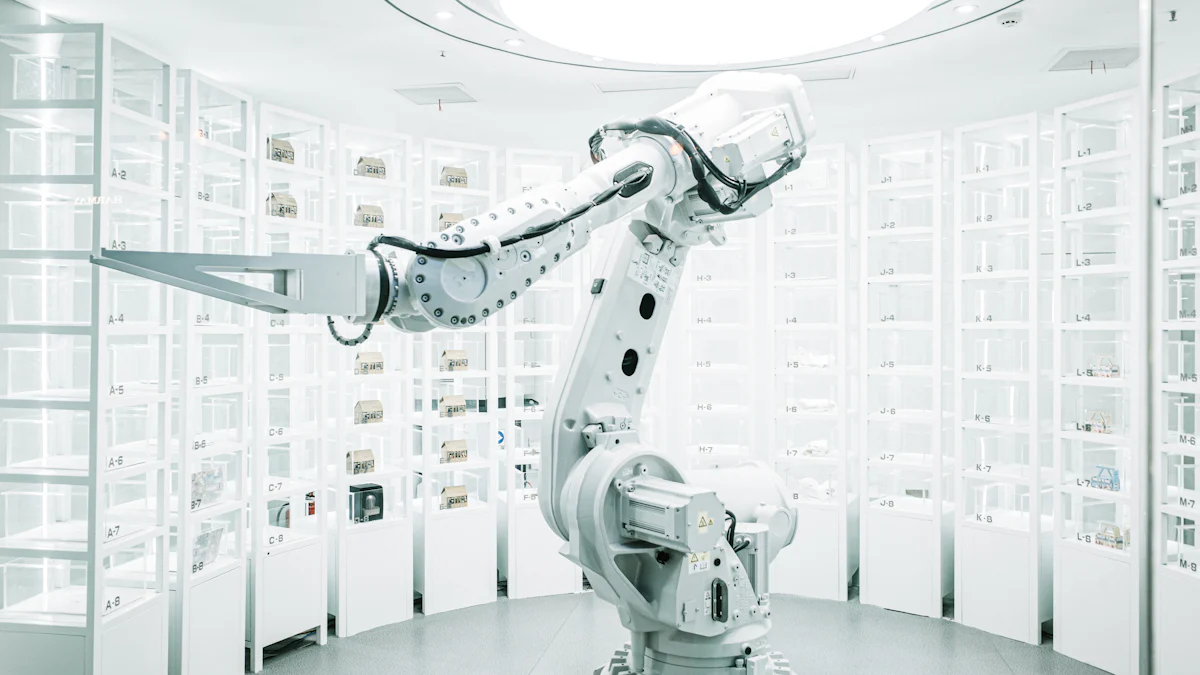How Researchers Use AI to Simulate Complex Scenarios

Artificial Intelligence (AI) has become a cornerstone in modern research, transforming how researchers approach complex problems. Its significance lies in its ability to process vast amounts of data and simulate intricate scenarios that were once beyond reach. Simulating complex scenarios is crucial for researchers as it allows them to explore possibilities and predict outcomes without real-world constraints. AI enhances these simulation capabilities by providing tools that can learn, adapt, and predict with remarkable accuracy. As a result, researchers use AI to push the boundaries of what is possible, opening new avenues for discovery and innovation.
Understanding AI in Research
Definition and Scope of AI
Artificial Intelligence (AI) refers to the simulation of human intelligence in machines. These machines are programmed to think and learn like humans. AI encompasses a wide range of technologies, including machine learning, natural language processing, and robotics. Researchers use AI to solve complex problems by analyzing large datasets and identifying patterns.
Historical Context of AI in Research
AI has a rich history in research. In the 1950s, scientists began exploring the possibility of creating machines that could mimic human thought processes. Early AI research focused on symbolic reasoning and problem-solving. Over the decades, advancements in computing power and data availability have propelled AI into new realms. Researchers have transitioned from rule-based systems to more sophisticated models that can learn from data.
Current Trends in AI Applications
Today, AI applications span various fields. In healthcare, AI assists in diagnosing diseases and personalizing treatment plans. Environmental scientists use AI to model climate change scenarios and predict natural disasters. In finance, AI algorithms analyze market trends and optimize investment strategies. These applications demonstrate AI's versatility and its growing importance in research.
Importance of AI in Modern Research
AI plays a crucial role in modern research. It enhances the efficiency and scope of scientific investigations.
Enhancing Research Efficiency
AI accelerates research processes by automating repetitive tasks. Machine learning algorithms analyze data faster than humans, allowing researchers to focus on interpretation and innovation. AI-driven simulations enable scientists to conduct numerous virtual experiments, reducing the time and cost associated with physical trials.
Broadening Research Horizons
AI expands the boundaries of research by enabling the exploration of previously inaccessible areas. Researchers can simulate complex scenarios that are difficult to replicate in real life. This capability allows them to study the impact of various factors on outcomes, leading to new insights and discoveries. AI also facilitates interdisciplinary research by integrating data from diverse fields, fostering collaboration and innovation.
Researchers Use AI in Simulation

Artificial Intelligence (AI) has revolutionized the way researchers simulate complex scenarios. By employing advanced techniques, researchers use AI to create models that mimic real-world processes with remarkable precision. This section explores the AI techniques utilized in simulations and highlights the diverse fields where researchers use AI to drive innovation.
AI Techniques for Simulation
Machine Learning Algorithms
Machine learning algorithms form the backbone of AI-driven simulations. These algorithms enable computers to learn from data and make predictions or decisions without explicit programming. Researchers use AI to analyze vast datasets, identifying patterns and trends that inform simulation models. For instance, in climate science, machine learning algorithms process historical weather data to predict future climate patterns. This approach allows researchers to simulate various environmental scenarios and assess potential impacts.
Neural Networks
Neural networks, inspired by the human brain, consist of interconnected nodes that process information. Researchers use AI to train these networks on large datasets, enabling them to recognize complex patterns and relationships. In simulations, neural networks excel at tasks such as image recognition and natural language processing. For example, in healthcare, neural networks analyze medical images to detect anomalies, aiding in disease diagnosis. By leveraging neural networks, researchers use AI to enhance the accuracy and reliability of simulations across multiple domains.
Researchers Use AI in Various Fields
Environmental Modeling
In environmental science, researchers use AI to model ecosystems and predict changes over time. AI-driven simulations help scientists understand the effects of climate change, deforestation, and pollution on natural habitats. By simulating different scenarios, researchers can evaluate the potential outcomes of conservation efforts and policy changes. This information guides decision-making and promotes sustainable practices. Researchers use AI to create detailed models that capture the complexity of environmental systems, providing valuable insights into ecological dynamics.
Healthcare Simulations
Healthcare is another field where researchers use AI to simulate complex scenarios. AI-powered simulations assist in medical training, allowing healthcare professionals to practice procedures in a virtual environment. These simulations replicate real-life situations, enabling trainees to develop skills and confidence. Additionally, researchers use AI to simulate patient responses to treatments, optimizing personalized care plans. By integrating AI into healthcare simulations, researchers enhance patient safety and improve clinical outcomes.
Researchers use AI to push the boundaries of what is possible in simulation. Through machine learning algorithms and neural networks, they create models that offer unprecedented insights into complex systems. Across various fields, researchers use AI to simulate scenarios that inform decision-making and drive progress. As AI continues to evolve, its role in simulation will expand, opening new avenues for exploration and discovery.
Implementing AI in Research Workflows
Data Collection and Preparation
Data collection and preparation form the foundation of any successful AI project. Researchers must ensure that the data they use is accurate, relevant, and comprehensive. Proper data preparation enhances the performance and reliability of AI models, making it a critical step in research workflows.
Data Cleaning Techniques
Data cleaning involves identifying and correcting errors or inconsistencies in datasets. Researchers employ various techniques to clean data, such as removing duplicates, correcting inaccuracies, and filling in missing values. These steps ensure that the data is of high quality and suitable for analysis. By maintaining clean datasets, researchers can improve the accuracy of AI models and reduce the risk of biased results.
Data Augmentation
Data augmentation is a technique used to increase the diversity of data available for training AI models. Researchers apply transformations to existing data, such as rotation, scaling, or flipping images, to create new examples. This process helps AI models generalize better by exposing them to a wider range of scenarios. Data augmentation is particularly useful in fields like image recognition, where diverse datasets can significantly enhance model performance.
Model Training and Validation
Once the data is prepared, researchers focus on training and validating AI models. This phase involves teaching the model to recognize patterns and make predictions based on the data.
Training Techniques
Training techniques vary depending on the type of AI model being used. Common methods include supervised learning, where the model learns from labeled data, and unsupervised learning, which involves finding patterns in unlabeled data. Researchers may also use reinforcement learning, where the model learns by interacting with an environment and receiving feedback. These techniques enable AI models to learn and adapt, improving their ability to simulate complex scenarios.
Validation Methods
Validation is crucial to ensure that AI models perform well on new, unseen data. Researchers use various methods to validate models, such as cross-validation, where the dataset is divided into subsets to test the model's accuracy. Another approach is the holdout method, which involves splitting the data into training and testing sets. By validating models, researchers can assess their performance and make necessary adjustments to enhance reliability.
Implementing AI in research workflows requires meticulous data preparation and robust model training and validation. These steps ensure that AI models are accurate, efficient, and capable of simulating complex scenarios. As AI continues to evolve, researchers will refine these processes, further enhancing the potential of AI-driven simulations in various fields.
Challenges in AI-Based Simulations
Data Privacy Concerns
AI-based simulations often require vast amounts of data, raising significant concerns about data privacy. Researchers must navigate the delicate balance between technological advancements and ethical considerations regarding privacy protection.
Ethical Considerations
AI systems can become highly knowledgeable about individuals, potentially challenging society's commitment to privacy. As AI technologies advance, they collect and analyze personal data more efficiently, which raises ethical questions. Researchers must consider how to protect individuals' privacy while utilizing AI's capabilities. The philosophical debate centers on whether the benefits of AI outweigh the potential risks to personal privacy.
Regulatory Compliance
Governments worldwide face increasing pressure to establish guidelines and regulations for AI technologies. In response to ethical concerns, the U.S. government has introduced measures such as an executive order and an AI Bill of Rights. These initiatives emphasize data privacy and responsible AI use. Researchers must ensure that their AI simulations comply with these regulations to protect individuals' rights and maintain public trust.
Technical Limitations
Despite AI's transformative potential, technical limitations pose challenges to its application in simulations. Researchers must address issues related to computational power and algorithmic bias to enhance AI's effectiveness.
Computational Power
AI simulations require substantial computational resources. The complexity of AI models demands high processing power, which can limit researchers' ability to conduct extensive simulations. Access to advanced computing infrastructure is essential for overcoming this challenge. Researchers must optimize their models to make efficient use of available resources, ensuring that simulations remain feasible and effective.
Algorithmic Bias
Algorithmic bias presents another significant challenge in AI-based simulations. Biases in AI models can lead to inaccurate predictions and unfair outcomes. Researchers must carefully evaluate their models to identify and mitigate biases. This involves using diverse datasets and implementing techniques to ensure fairness and accuracy. Addressing algorithmic bias is crucial for maintaining the integrity and reliability of AI simulations.
Future Prospects of AI in Research
Emerging Technologies
Quantum Computing
Quantum computing stands poised to revolutionize AI applications. Researchers believe that quantum computing can significantly enhance AI capabilities by overcoming current limitations related to data size, complexity, and speed. For instance, in healthcare, quantum computing can work alongside AI to improve protein structure prediction. This collaboration could lead to groundbreaking discoveries and more efficient problem-solving methods. As quantum computing technology advances, it will likely unlock new possibilities for AI, enabling researchers to tackle challenges that were previously insurmountable.
AI and IoT Integration
The integration of AI with the Internet of Things (IoT) presents another promising frontier. IoT devices generate vast amounts of data, which AI can analyze to provide valuable insights. By combining AI with IoT, researchers can create smart systems that monitor and respond to real-time conditions. For example, in environmental science, AI-powered IoT sensors can track climate changes and predict natural disasters. This integration enhances the ability to simulate complex scenarios, offering more accurate predictions and informed decision-making. As AI and IoT technologies continue to evolve, their synergy will drive innovation across various fields.
Potential Impact on Research Fields
Transformative Changes
AI's future prospects promise transformative changes in research fields. By simulating complex scenarios with greater accuracy, AI can reshape how researchers approach problems. In healthcare, AI-driven simulations can lead to personalized treatment plans and improved patient outcomes. Environmental scientists can use AI to model ecosystems and assess the impact of conservation efforts. These transformative changes will enable researchers to address pressing global challenges more effectively, paving the way for a more sustainable future.
New Research Opportunities
The advancement of AI technologies will open new research opportunities. As AI becomes more sophisticated, researchers can explore previously inaccessible areas. For instance, AI can simulate rare weather phenomena, helping scientists understand and predict extreme events. In finance, AI algorithms can analyze market trends and optimize investment strategies. These new opportunities will foster interdisciplinary collaboration and innovation, driving progress across diverse fields. As AI continues to evolve, its potential to unlock new avenues for exploration and discovery will only grow.
Case Studies of AI in Simulating Scenarios

Successful Implementations
Case Study 1: AI in Healthcare
AI Healthcare Transformations showcase how AI revolutionizes medical interactions. Researchers have implemented AI to identify diseases with greater speed and accuracy. This technology streamlines drug discovery processes and monitors patients through virtual nursing assistants. For example, AI systems analyze medical images to detect anomalies, aiding in early diagnosis and treatment. These advancements highlight AI's potential to enhance healthcare delivery and improve patient outcomes.
Disease Identification: AI algorithms process vast amounts of medical data to recognize patterns indicative of specific diseases.
Drug Discovery: AI accelerates the identification of potential drug candidates by analyzing chemical structures and biological interactions.
Patient Monitoring: Virtual nursing assistants use AI to track patient health metrics, providing timely alerts to healthcare providers.
Case Study 2: Data Preparation for AI Models
Data Preparation for AI Models emphasizes the importance of meticulous data handling. Researchers have found that carefully prepared data significantly enhances AI model performance. By cleaning and augmenting datasets, AI systems become more accurate and efficient in their predictions. This approach proves essential in fields like image recognition, where diverse datasets improve model reliability.
Data Cleaning: Researchers remove errors and inconsistencies from datasets, ensuring high-quality inputs for AI models.
Data Augmentation: Techniques such as image rotation and scaling increase data diversity, helping models generalize better.
Performance Improvement: Models trained on well-prepared data outperform those using unprepared datasets, demonstrating the value of thorough data preparation.
Lessons Learned
Key Takeaways
From these case studies, several key takeaways emerge:
AI's Versatility: AI's ability to process and analyze large datasets makes it invaluable across various fields, from healthcare to environmental science.
Importance of Data: High-quality data is crucial for AI model success. Proper data preparation enhances model accuracy and efficiency.
Interdisciplinary Collaboration: AI fosters collaboration between different research fields, leading to innovative solutions and discoveries.
Best Practices
To maximize AI's potential in simulations, researchers should consider the following best practices:
Invest in Data Quality: Prioritize data cleaning and augmentation to ensure reliable AI model performance.
Leverage AI's Strengths: Utilize AI's capabilities in pattern recognition and prediction to explore complex scenarios.
Encourage Collaboration: Foster interdisciplinary partnerships to harness diverse expertise and drive innovation.
These case studies illustrate AI's transformative impact on simulating complex scenarios. By learning from successful implementations and adopting best practices, researchers can continue to push the boundaries of discovery and innovation.
Conclusion
Recap of AI's Role
Simulating Complex Scenarios
AI has become a powerful tool for simulating complex scenarios. Researchers use AI to model intricate systems and predict outcomes with remarkable accuracy. This capability allows them to explore possibilities that were once unimaginable. AI's ability to process vast amounts of data and identify patterns makes it invaluable in fields like healthcare, environmental science, and finance. By simulating complex scenarios, researchers gain insights that drive innovation and inform decision-making.
Transformative Potential
The transformative potential of AI is evident in its impact across various industries. AI systems analyze data and convert findings into visual formats, accelerating the decision-making process. This transformation enables researchers to tackle challenges more effectively and efficiently. AI's role in research continues to expand, opening new avenues for exploration and discovery. As AI technology advances, its influence will grow, shaping the future of humanity in profound ways.
Future Outlook
Closing Thoughts
AI's future prospects are promising. The steady advances in AI technology and increased investment suggest that AI will become even more powerful and impactful in the coming years. Researchers will continue to refine AI models, enhancing their accuracy and reliability. The integration of emerging technologies like quantum computing and IoT will further expand AI's capabilities. As AI evolves, it will unlock new opportunities for research and innovation, transforming how we approach complex problems. The journey of AI in simulating complex scenarios is just beginning, and its potential to revolutionize research is limitless.
AI plays a pivotal role in simulating complex scenarios, allowing researchers to model intricate systems and predict outcomes with precision. This capability opens up possibilities that were once unimaginable. AI's transformative potential is evident across various industries, from healthcare to environmental science. It accelerates decision-making processes by analyzing data and converting findings into actionable insights. As AI technology advances, its influence will grow, shaping the future of research and innovation. The journey of AI in simulating complex scenarios is just beginning, promising limitless opportunities for exploration and discovery.
See Also
The Role of Generative AI in Scientific Research
Authors Partnering with AI for Creative Writing
Crafting Film Scripts using Generative AI
